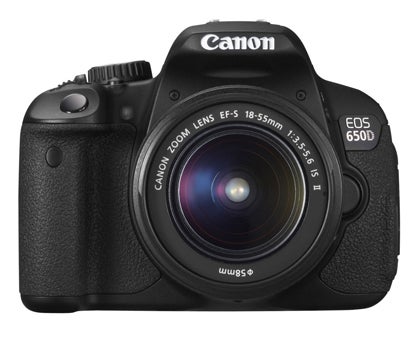The Canon EOS 650D is the world's first DSLR to be equipped with a touchscreen also arrives with a clever focusing system and a handful of extra features. The What Digital Camera Canon EOS 650D review investigates the extent to which their implementation has been successful
Canon EOS 650D Review
Performance
Canon EOS 650D review – Performance
Extensive use of the touchscreen makes it obvious how useful this technology can be when well integrated. Those likely to benefit and appreciate it the most will be those using live view and the articulation of the LCD with some frequency, particularly when the usefulness of the touch-shooting is considered. When activated, this allows the subject to be tapped on screen, after which the camera will either focus and keep a lock on the subject, or focus and expose the frame, depending on the settings defined by the user. Although the camera keeps a lock on the subject well, it only maintains this providing it stays well within the peripheries of the frame – otherwise it loses it entirely.
While the camera’s more standard focusing system was adequate on the EOS 600D, the revision to an all cross-type system should theoretically make it an even better performer. A side-by-side comparison with the EOS 600D shows this to largely be true, with certain flat, low-contrast subjects completely missed by the EOS 600D’s peripheral points being picked up with a much higher rate success rate with the EOS 650D.
The screen itself is pleasingly responsive, at least as prompt as an average smartphone if not more so. When using a finger to zoom around an image, it image moves promptly and with no lagging, and when moving through the main menus you simply need to lift your finger off at the relevant function for it to bring up its various options. Pressing the Q button when in live view also reveals commonly used functions bordering the screen, with the options within each one at the base and all being operated by touch. Overall, Canon has gone beyond expectations to deliver a screen that actually changes the whole user experience, rather than one which just allows certain functions to be selected on screen.
Yet, there’s room for improvement. When reviewing images, double-tapping the screen fails to do anything, when it could so easily be used to zoom into the image to 100%. It also takes a fraction of a second to render the image in its full quality as images are swiped. It’s entirely likely that those with larger hands may be less enamoured by the implementation, given the relatively small dimensions of many of the controls. While average-handed users are unlikely to feel the need for a stylus of any kind, it’s difficult to imagine these controls being any smaller while remaining usable, particularly within the main menu system which follows the same basic template as previous EOS models.
Even ignoring the touchscreen technology the display is more than capable in its performance. While it suffers from the same visibility issues in stronger light as any other camera, in more balanced conditions it presents the scene naturally and without issues. While it isn’t based on the OLED technology that has impressed us elsewhere the viewing angle is still impressively wide; a side-by-side comparison with the EOS 600D shows this to be noticeably improved from before.
As promised, the new EF 40mm f/2.8 STM lens delivers a smoother focusing performance than more conventional optics, with greater fluidity when focusing between different areas, although it’s noticeably slower to achieve focus. The greatest difference, however, is its sound as it’s doing so; whereas the focusing motor of an optic such as the EF-S 18-55mm f/3.5-5.6 IS II delivers a more obvious scratching sound as it achieves correct positioning, the motor inside the pancake lens is closer to a low hum. In silent conditions the sound of both is apparent, although when ambient noise is present the 40mm lens’s motor cannot be heard.
The built-in microphones manage to capture sound with impressive clarity, although their sensitivity does make them susceptible to ambient noise, wind etc. Although there is only a basic level of control provided over audio recording (which is entirely expected), there is a wind cut filter which attempts to help out in more turbulent conditions. Comparing footage shot with and without this employed reveals that this does indeed have an effect, although by cutting out the most obvious high-frequency details it still leaves a low rumble, leaving these sounds noticeable but just less obviously so.
One of the less headline-grabbing features of the camera is its 5fps burst speed, which still falls short of peers such as Sony’s A57 and Pentax’s K-30, although admittedly it’s an improvement over the 4fps Nikon D5100. While the camera meets its promised 6-frame depth when shooting JPEGs only, it seems impossible to record its promised 22 JPEG frames at a consecutive speed, even with the fastest card available and all processing options kept to a minimum. Worse still, the depth for Raw and JPEG images appears to be a paltry three frames at consecutive speed.
The HDR Backlight Control setting doesn’t produce a radical HDR image as such, but attempts more to produce an image with better detail throughout lighter and darker areas. Examining the histograms of these images shows the feature to successfully reduce contrast by bringing up shadows and taming highlights, although as this requires three consecutive exposures which are then merged together critical sharpness is lost. In less extreme conditions, therefore, it may be better to simply shoot a single Raw image with better sharpness and gently process the shadows and highlights in post-production.
Finally, the Creative Filters can be easily applied to images once captured, and their effects can generally be varied over three levels to achieve different effects. The only criticism that can be levelled here is the speed at which this happens, as it’s slower than expected. Those wanting to process a number of images in one go may find this somewhat tardy, although processing images post-capture at least retains the original version.









